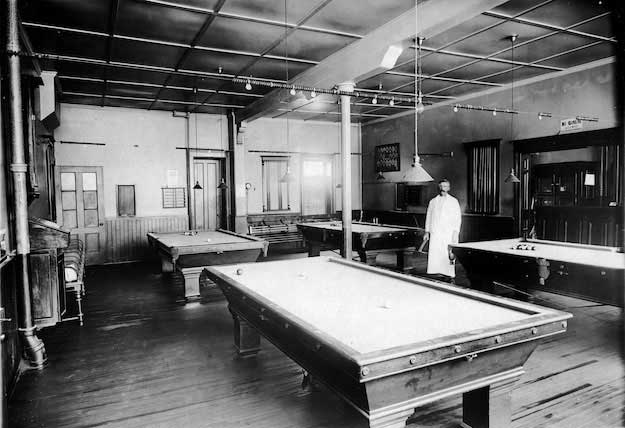Billiards was a popular, competitive pastime at the Orleans House in Albion
“Overlooked Orleans” – Vol. 6, No. 17
ALBION – This photograph, taken circa 1920, shows the billiard parlor in the Orleans House located on the southwest corner of Platt and East Bank streets in Albion. Anson Dunshee was the proprietor of the hotel at the time, so it is possible that he is the man pictured here.
In January of 1895, Dunshee ordered four new Babcock billiard tables for installation in this parlor at a cost of approximately $1,000. Three of the four tables in this image appear to be the same style, consisting of square legs, slate tops, and leather mesh pockets. At the time this photograph was taken, eight-ball pool was already popular in the United States.
Three of the tables are racked with a mix of solid and striped balls, typical of that particular version of the game. Eight-ball pool originally consisted of a point-based system where each player was awarded points for sinking each ball based on the ball’s corresponding number. A total of 120 points could be earned and the first player to reach 61 points, or one more than half of the total points, won the game. This was likely the version played at this venue. Readers will notice two wires running along the upper portion of the photograph near the ceiling. Known as the “wire” or “across the string,” these beads formed an abacus used for scoring the game. A darker bead marked one point while a lighter colored pendant marked every ten points.
The fourth table, situated front and center of this photograph, has no pockets. This type of table was used in carom billiards, also known as carambole billiards, where players scored points by bouncing the cue ball off the rails and two other balls situated on the table; points were awarded based on the complexity of the shot. The darker ball is visible in the corner of the table while two lighter colored balls are also situated on the felt. Players typically engaged in several variations of carom billiards including straight rail, cushion caroms, balkline, and three-cushion billiards. Cue sticks are held in racks mounted on the walls and mechanical bridges can be seen underneath the tables.
In May of 1876, the Orleans House hosted Frank “Yank” Adams, a professional carom billiards player known for his ability to manipulate the cue ball with his hands. Combining his proficiency in bowling with billiards, Adams was able to make trick shows with his digits rather than using a cue, which earned him the nickname, “Digital Billiard Wonder.”
During the 19th century, pool rooms were typically associated with betting parlors for horse racing. The billiard tables provided bettors with an activity to pass the time between races. The term “pool” became synonymous with billiards as the game was commonly associated with collective betting or antes. This would explain the presence of the “No Gambling Allowed in this Room” sign hanging over the doorway into the barroom.
Although the available identifying information suggests that this image was taken around 1920, the exact date is likely a few years earlier. Around 1922, Dunshee proceeded to renovate the billiards parlor and adjoining barroom into a restaurant. The inability to gamble and recent enactment of the 18th Amendment likely killed any interest in billiards. Earlier in that same year, the hotel was raided by Sheriff Scott Porter under the suspicion of selling illegal intoxicating liquor (v. 3, no. 22).



























































